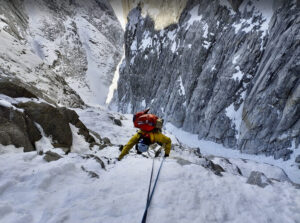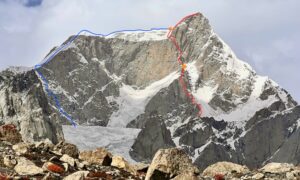The industrialization of high-altitude climbing that happened on Everest years ago has reached the rest of the 8,000’ers, and the effects are particularly significant on K2. On July 22, roughly 150 people formed an Everest-style conga line between Camp 4 and the summit. With high temperatures increasing rockfall and making the ice more unstable, some say that it was only luck that this crowding didn’t trigger a tragedy. What can we learn from this season on K2?
Lesson #1: Waste Management

Trash at Camps 1 and 2. Photo: Sarah Strattan
Camps 1 and 2 are disgusting, said Sarah Strattan; a pigsty, said Flor Cuenca. The problem is not exclusive to K2, and it doesn’t only occur in high-altitude camps.
“Though we paid the proper fee to have our garbage taken out from Base Camp, we are not sure it wasn’t just thrown in a crevasse, as seems to be standard practice,” wrote Ian Welsted, who attempted the Southwest Ridge last year.
Both Welsted and Strattan also called for something to be done with abandoned fixed ropes, which they perceive as both “another form of trash” and a potential safety issue.
Many climbers have denounced the poor state of the entire Baltoro area and the lack of a proper management plan. Others point out that the higher camps on Nepal’s most popular peaks are equally bad.

Which rope is safe and which is not? A dangerous dilemma in K2’s House Chimney. Photo: Sarah Strattan
“I think solutions exist to fix many of these problems,” Sarah Strattan wrote. Indeed, the Central Karakoram National Park already provides a cleaning service. This year, it also sent a group of porters to retrieve trash. But they will be able to remove only a fraction of what has been accumulating for years.
The key is not just cleaning. Mainly, it’s not littering. Up in the thin air, only the climbers themselves decide if they are going to do something about garbage. The future of the very industry is at stake. High-altitude climbing is motivated both by self-reward and external recognition. If instead of applause, climbers receive criticism for leaving the mountain in such a state, they may end up deciding that it is not worth paying tens of thousands of dollars to climb a garbage heap, only to be slagged when they succeed.
In particular, it is hypocritical for climbers to make all the right noises about climate change and sustainability, then be selectively blind to a problem that they are worsening.
Lesson #2: Sustainable climbing strategies
Obviously, the more you take up to the mountain, the more you have to bring back down. As Everest expedition leader Damian Benegas has said in a number of interviews (here’s one with Thom Pollard, minute 24), part of the problem is the huge amount of gear that bigger groups shuttle up.
The less experienced clients need more Sherpa support. The more support, the bigger the footprint — more empty oxygen bottles, more food wrappers, more human waste. Mountaineers have debated for decades how fit and skilled someone should be to attempt an 8,000m peak, and whether it’s possible to control that.

A Sherpa short-ropes a client to the tent door at Broad Peak’s Camp 2. Frame from a video by @popuplens
Also, companies compete to offer luxury at Base Camp and comfort higher up. More potential for garbage. Ideally, the gear and supplies carried up a mountain should be limited. Ideally too, even oxygen could be allowed only for emergencies, and otherwise used only on the way down, not on the way up. But, yeah, we know, the world is far from ideal.

Sherpas at House’s Chimney on K2.
Lesson #3: Human resources
Personnel management is another delicate can of worms. Every year, some climbers complain about a lack of professionalism from their local porters or guides, especially in Pakistan. (See reports by Fishtri of Taiwan on K2 and Pawel Michalski on Nanga Parbat.)
Others argue that you get what you pay for: Unskilled porters won’t perform as well as veterans, who charge more. This is nothing new and is not exclusive to K2, but there is ample room for improvement. Unlike Nepal, Pakistan does not have mountaineering schools where young, would-be guides can learn their trade.

Frame from the viral video by Mingma G, showing a long line of climbers below the precarious Great Serac on K2, July 22, 2022.
Likewise, Pakistan could use an official rescue service, not only for paying clients but also for local porters and climbers. Helicopters are not as available here as in Nepal. Besides, the steep Karakoram peaks, especially K2, make long-line rescues difficult. Ground teams are often not available.
Also, the era when a handful of climbers pitched in during emergencies on the mountain is over. It’s not because we’re meaner now. Mainly, most clients are not skilled enough to help others. Their guides’ primary responsibility is toward them, so they cannot just abandon their professional obligations to launch rescues. This year on K2, two climbers died in accidents, while Afghan climber Ali Akbar Sakhi perished from AMS near Camp 3.
Finally, it should go without saying that local porters have the same rights as anyone else. On Spanish-speaking forums, a heated controversy recently erupted over comments made by Lina Quesada. She bragged that she had summited K2 “alone” on July 22, because her porter stopped at 8,300m. He allegedly felt sick, she said.
Besides the unlikelihood of being alone among nearly 150 other climbers who summited on that day, Quesada faced a spectacular backlash when she reported that she told the porter to wait for her at 8,300m until she returned from the summit, in case she needed him during the descent. Apparently, the porter carried an extra oxygen canister for her.
Audiences accused the climber of a lack of ethics, even humanity, for leaving a sick worker waiting in the Death Zone for hours. She tried to counter the attacks by alleging that the porter was actually not sick and was only pretending, to get more money. That made readers even angrier. Quesada then deleted her posts on the topic. The story remains available at Andalusia’s Mountain Federation site.
The obvious lesson: Treat everyone, including those working for you, like human beings rather than disposable assets. And try to deal with reputable agencies where the high-altitude staff always do their best rather than with bottom-dollar outfits.
Lesson #4: Marketing — for tourists and local heroes only
Outfitters fill social media with grandiose messages about heroes, record, history, etc. It has become nearly impossible to keep track of all these thinly parsed firsts. The fact is, few high-altitude climbers do anything truly extraordinary any more.

Left to right, Dawa Ongchu, Kristin Harila, and Pasdawa Sherpa. The three have bagged eleven 8,000’ers in 106 days. Photo: Kristin Harila
Some years ago, the first Pakistani woman to summit K2 made headlines. This year, Samina Baig and Naila Kiani both did it on the same day. Local media gives obligatory brief coverage, but repetitiveness has thinned public interest.
An overwhelming number of climbers claim records of some kind: speed, age, nationality, number of summits in a given time, etc. As we often mention at ExplorersWeb, records in high-altitude mountaineering are tricky to assess. Often, current records say more about superior contemporary logistics than climbing skills.
Lesson #5: Cooperation
Not long ago, a handful of climbers gathered in a small base camp, hoping to climb a big mountain. In such conditions, cooperation was natural because a bigger team meant more summit options. Conflict did occur, but cooperation was generally expected.
Nowadays on the 8,000ers, crowds, millions of dollars at stake, and limited room in higher camps have created a new source of conflict. Cooperation can’t be taken for granted.
The biggest outfitters reach the higher camps first and fill the available space. Some even put ropes around their “territory”. This led to at least two quarrels at Camp 2 on Broad Peak. Some leaders became quite aggressive. Independent climbers and those going without oxygen and so heading up last are the most harmed by the lack of space.

K2 Base Camp. Photo: Gao Li
Traffic jams led to long waits at the Bottleneck and elsewhere on July 22, including House’s Chimney. Big groups of incautious climbers dislodged rocks as they went up, right above other climbers. This happened especially between Camps 2 and 3.
Finally, some climbers who launched their summit push right after the big July 22 wave had their last good night of sleep in Base Camp spoiled by noisy parties. These included firecrackers and music blasting until near dawn.
Eric Gilbertson of the U.S. teamed up with Andreas Frydensberg of Denmark to summit Broad Peak and then K2 on July 28 without O2. Now back home, he has written one of the most detailed and interesting expedition reports of the last few K2 seasons.
In it, Gilbertson addresses some of these issues. He spares no details about the camps wallowing in garbage and reeking of excrement, hard parties in Base Camp, careless climbers bombarding those below with falling rocks, the Italian team’s lack of cooperation during the summit push, and how Benjamin Vendrines passed out on his way down and had to receive O2 from a Sherpa.

Eric Gilbertson’s selfie during his no-O2 summit push on K2. Photo: CountryHighPoints.com
Here is what he said about K2’s tent use ethics:
The camp locations are so small that they can’t possibly sleep all climbers at the same time. But climbers generally leave tents set up in camp to claim spots. So the ethics are generally that you are allowed to sleep in a tent if it is empty, since there may be no spots available to pitch your own tent. This was formally agreed upon by all the major expedition leaders at a meeting in K2 BC at the beginning of the season to cope with the unprecedented crowds on the mountain.
If you sleep in another person’s tent you obviously should leave everything inside undisturbed and zip it back up when you leave. But, unsurprisingly, many climbers are not very considerate. On Broad Peak, some climber slept in my tent in c2 (even though there were empty sites available where they could have pitched their own). Then they left the door and vestibule unzipped right before a storm. When I found it, the vestibule was ripped off, sides were ripped, and snow had filled the inside! In the future, I will will lock the entrance of my tent on 8,000m peaks.

Ragged tents and garbage at K2’s Camp 2. The Black Pyramid looms above. Photo: Eric Gilbertson
A mountain is like a community where strangers are forced to share limited space in difficult conditions while performing in extreme environments. People usually apply common sense, but the more people there are, the harder it becomes to keep harmony.






